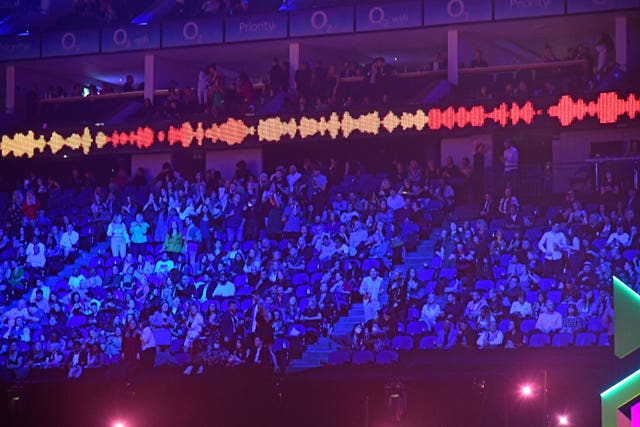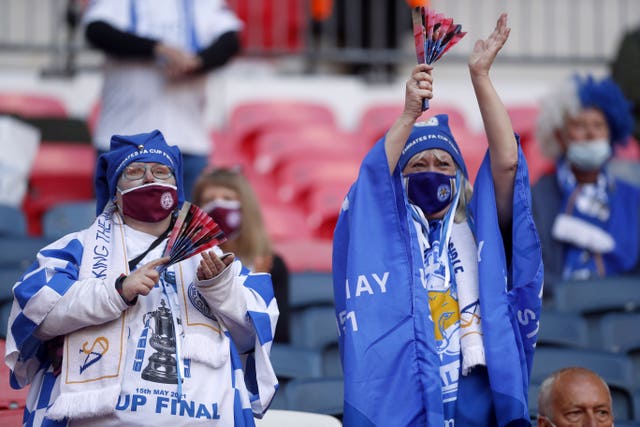
A pilot scheme exploring the impact of large-scale events on Covid-19 transmission has found “no substantial outbreaks”, recording 28 associated cases of infection out of tens of thousands of participants, according to a new report.
The Events Research Programme (ERP), commissioned by the Prime Minister in February, saw 58,000 participants attend indoor and outdoor venues across the country, including in Liverpool, Sheffield and London.
READ MORE: Holiday bookings surge after green list announcement
The ERP aims to assess the safety of mass gatherings during the pandemic and whether they affect rates of infection.
A delayed report on data from the first nine pilots of the ERP’s first phase in April and May, which featured the FA Cup final, the Brit Awards and the World Snooker Championship, revealed 28 associated positive cases of Covid-19.
 The 2021 Brit Awards was a test event (Ian West/PA)
The 2021 Brit Awards was a test event (Ian West/PA)
Of these, 11 were identified as “potentially infectious at an event” while a further 17 were “potentially infected at or around the time of an event”, the report published on Friday said.
The report warned the figures should be interpreted with “extreme caution” due to the low return rate of tests, low prevalence of Covid-19 at the time of the pilots and lack of a comparison group for the studies.
Its release comes after theatre impresario Andrew Lloyd Webber and other figures from entertainment sectors launched legal action to force the Government to hand over the results from the ERP scheme.
Its first phase saw 10 Covid-19 cases recorded from those at the Circus nightclub in Liverpool, which hosted nearly 7,000 people over two nights.
READ MORE: Fans gathering for Euro 2020 matches blamed for surge in Covid cases among men
Some six cases were recorded from the more than 10,000 attendees at the World Snooker Championship that took place over 17 days.
No cases were found among the 3,500 people at the Brit Awards at London’s O2 Arena, while a combined eight cases were recorded out of the nearly 30,000 fans attending the FA Cup semi-final and final and the Carabao Cup final.
An outdoor festival pilot at Liverpool’s Sefton Park, where more than 6,000 attended, saw two cases, and the Reunion 5k run at Kempton Park in Surrey also recorded two cases from 2,000 attendees.
While the report said “no substantial outbreaks were identified by public health teams and their surveillance systems around any of the events” it said “direct evidence of the risk of coronavirus transmission at specific types of events could not be drawn from Phase I of the pilots”.
This was due to “the low prevalence of Covid-19 at the time of the pilot events; low levels of pre- and post-event PCR return and the limited scale, scope and design of pilots”.
Across all events only 15% of ticketholders included in the analysis returned both pre and post-event PCR tests.
Professor Iain Buchan, executive dean, Institute of Population Health, chairman of public health and clinical informatics, Faculty of Health and Life Sciences, University of Liverpool, said: “There’s a lot more data being analysed and further information will come out.
“But the main findings you have before you – findings that tell us good ventilation, quick action on test results, not attending the event if feeling unwell, were critical areas where even further improvements are possible.
READ MORE: Hospitals 'full and bursting' amid signs that pandemic backlog starting to hit NHS
“Hence, further phases of this work, and lessons for implementation.”
He added that the report was “reassuring” that public health services can put outbreak prevention and control in place when working in partnership with the event organisers.
Professor Paul Monks, chief scientific adviser, Department for Business, Energy and Industrial Strategy, said the numbers were not too different from coronavirus prevalence in the community at the time.
He added: “The reassurance is it’s not that different to what you would have got with or without the event.
“But that’s a measure of the level of prevalence and the protection protocols we had in place.
Prof Buchan said: “Many of us who’ve been to these events have been very moved as well.
“I have never seen a crowd of 6,000 people suddenly burst into happy tears – an outbreak of joy, rather than an outbreak of a virus, it was incredibly moving.”
 Compliance with the wearing of face coverings was high (Matt Childs/PA)
Compliance with the wearing of face coverings was high (Matt Childs/PA)
In a foreword Nicholas Hytner and David Ross, chief advisers for the ERP, said the report “does not make conclusive public health recommendations on the reopening of events at this stage”.
They highlighted that studies took place during low prevalence of coronavirus, adding that “future public health measures need to adapt to the prevailing levels and patterns of the virus”.
Participants in phase one had to return a negative lateral flow test result to attend events and were asked to voluntarily take pre and post-event PCR tests to support research.
READ MORE: What are the symptoms for the Delta variant and how do they differ?
A range of measures to combat transmission of coronavirus were used at the events, including staggered entry and exit times, ventilation, social distancing and face masks.
The report, which saw input from scientific experts, said that “mitigation measures” – such as face coverings, ventilation, testing, social distancing and restrictions on food and drink – can be used to reduce and manage risks at events.
The report observed that levels of risk vary by venue, with outdoor spaces “generally lower risk than indoor spaces”.
It highlighted that higher risk areas include those which have an increased density of people for longer periods of time, for example half-time at a football match, and where ventilation is poorer.
Such higher density puts “increased pressure on pinch points”, such as toilets.
 Revellers at a nightclub in Liverpool for a Covid safety pilot event (Richard McCarthy/PA)
Revellers at a nightclub in Liverpool for a Covid safety pilot event (Richard McCarthy/PA)
The report also warned that “large unstructured gatherings indoors” where people mix in close proximity pose a higher risk.
It observed that compliance with requirements to socially distance and wear face masks were “mostly high”, with lower face covering compliance associated with “higher attendance levels, circulation zones and exiting”.
Hospitality areas and people congregating in groups also saw people not wearing face coverings.
Overall the report observed that an average of 96.2% of people in sampled areas wore face coverings correctly while seated, particularly indoors (98.3%), while at outdoor events it was 92.1%.
READ MORE: The most common myths about Covid vaccine ... and the question that is perfectly legitimate
The report also said that “nearly all CO2 levels” recorded at events “were within the bounds of reasonable ventilation benchmarks with outdoor spaces clearly better for ventilation than indoors”.
The report noted that the ERP will continue to gather evidence from further events in subsequent phases.
Culture Secretary Oliver Dowden said: “Our innovative and science-led Events Research Programme is helping us to better understand how the risk of transmission at major events can be effectively mitigated.
“The findings and learnings will help event organisers plan for large audiences as we move to Step 4 of the road map.”
Mr Hytner said: “These events are so important for our wellbeing, our sense of community and togetherness, and they have been sorely missed.
“This programme has shown that through the public demonstrating their status we have been able to track the virus, creating a safer space for the public to get back to the events they love.
“The findings from the first phase of this programme will help facilitate the return of what so many of us enjoy: attending exciting and top quality events throughout the country when it is safe to do so.”




Why are you making commenting on The Herald only available to subscribers?
It should have been a safe space for informed debate, somewhere for readers to discuss issues around the biggest stories of the day, but all too often the below the line comments on most websites have become bogged down by off-topic discussions and abuse.
heraldscotland.com is tackling this problem by allowing only subscribers to comment.
We are doing this to improve the experience for our loyal readers and we believe it will reduce the ability of trolls and troublemakers, who occasionally find their way onto our site, to abuse our journalists and readers. We also hope it will help the comments section fulfil its promise as a part of Scotland's conversation with itself.
We are lucky at The Herald. We are read by an informed, educated readership who can add their knowledge and insights to our stories.
That is invaluable.
We are making the subscriber-only change to support our valued readers, who tell us they don't want the site cluttered up with irrelevant comments, untruths and abuse.
In the past, the journalist’s job was to collect and distribute information to the audience. Technology means that readers can shape a discussion. We look forward to hearing from you on heraldscotland.com
Comments & Moderation
Readers’ comments: You are personally liable for the content of any comments you upload to this website, so please act responsibly. We do not pre-moderate or monitor readers’ comments appearing on our websites, but we do post-moderate in response to complaints we receive or otherwise when a potential problem comes to our attention. You can make a complaint by using the ‘report this post’ link . We may then apply our discretion under the user terms to amend or delete comments.
Post moderation is undertaken full-time 9am-6pm on weekdays, and on a part-time basis outwith those hours.
Read the rules here